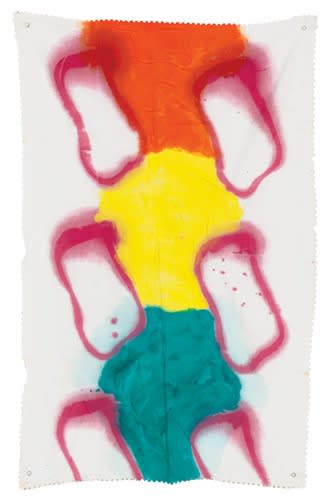Viallat’s minimalist variations achieve maximum impact.
The painter Claude Viallat is a resident of Nîmes, the city of his birth in southern France, where (non-lethal) bullfighting is a venerable tradition. Exploring the boundaries of convention, his tool of artistic renewal over the past fifty years has been a stencil. This may be rather unexpected given that stencilling is usually associated with standardisation. However, in the ceaseless repetition of one shape Viallat expresses his rejection of the fundamental principles of painting.
Despite the use of the same form, each of Viallat’s paintings is nevertheless distinct. This is due not least to the supports he employs. His “canvases” are old table cloths, bed-sheets or tarpaulins; he stitches together worn aprons and pillow-cases, frayed jute bags and umbrella fabrics. Ripped or showing other signs of wear and tear, these textiles form an integral part of his works, as do stripes or floral patterns, which Viallat does not overpaint. Different weaves also inscribe themselves into his works. Alongside the stencil, the fabrics constitute a major design element. Moreover, Viallat pushes the boundaries of conventional art even further: shunning traditional stretchers, he hangs his pieces as they are, which is usually soft and occasionally rather irregular in shape.
Born in 1936, Viallat studied art in Montpellier and Paris. He was a co-founder of Support/Surfaces, France’s most significant art movement in the latter part of the twentieth century. Pushing the boundaries of artistic convention, he has explored the effects of various supports and surfaces. His rejection of the conventional canvas and stretcher stands for his radical opposition to the inherent limitations of the traditional, framed painting.
Both in France and internationally, Viallat has been celebrated as one of art’sgreat and radical innovators. Many prestigious art museums proudly display his works, including MOMA, New York City; the Centre Pompidou, Paris; the Musée des Beaux Arts, Montreal, and the National Museum of Art, Osaka – to name just a few. Moreover, he has represented France at the Venice Biennale on two occasions.
Viallat’sr adical concept does not rest on his choice of unconventional supports alone. His subject matter also rejects the convention of painting as a reflection (of reality). He has employed the same stencil shape for decades, a simple yet mysterious form which is neither organic nor geometrical but a kind of oblong with rounded corners that has rather dismissively been called a potato, an amoeba, a wet sponge – or even a Cubist question-mark. French art historian Bernard Ceysson has famously noted that "the endless repetition of [Viallat’s]signature shape [...] appears as a sort of fusion, the metamorphosis of a woman’s body and that of a bull. This form may just as well represent the daughter of Minos and Pasiphaë, as be the self-generated offspring of a canvas arena, a corrida opposing the painter and his painting in face to face combat."
Even a less effusive critic will come to the conclusion that this artist has found his ideal form precisely because it is so “random”, signifying nothing, yet able to signify everything as the stencilled form appears in all-over-patterns across all kinds of textiles.
Viallat’s minimalist variations achieve maximum impact. Some of his pieces are the length of a large banner while others consist of different textiles. Colours and patterns vary, as does the way in which the stencil is applied. One piece may include an apron tie; elsewhere a hole in the fabric quite naturally becomes a feature. Rather than attempting to impose his concepts on the material, the artist takes inspiration from any imperfections, responding to the fabric as to a protagonist in its own right. Viallat has created works that face the viewer openly and without guiding the eye, leaving him or her free to interpret them as they will.
Alice Henkes

